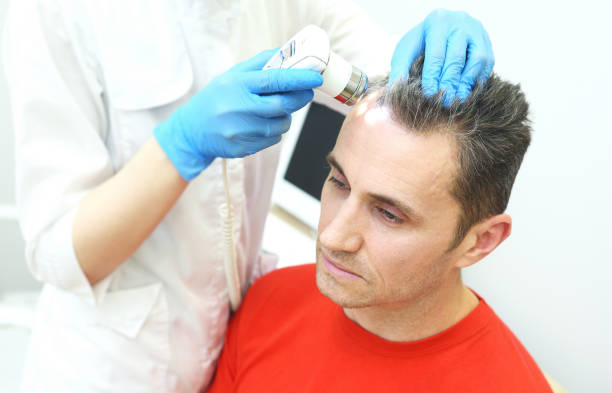Alopecia areata guide: treatment and prevention
Alopecia areata is an autoimmune disease that attacks hair follicles, causing patchy hair loss. Medications and therapies can help regrow hair, but severe cases may not respond to treatment. Understanding alopecia areata can be helpful in understanding and treating it.

Alopecia areata is a common autoimmune disorder that causes patches of hair loss when the immune system mistakenly attacks hair follicles. While it can affect anyone regardless of age or gender, most cases begin before the age of 30. The condition can range from small, coin-sized bald patches to complete loss of hair on the scalp (alopecia totalis) or entire body (alopecia universalis). Although there’s no definitive cure, numerous treatments can help manage symptoms and encourage hair regrowth.
Understanding alopecia areata and its causes
Alopecia areata occurs when white blood cells attack the cells in hair follicles, causing them to shrink and dramatically slow down hair production. The exact trigger remains unknown, but genetic factors play a significant role, with about 20% of people with the condition having a family history. Environmental factors may also contribute to its development. Common symptoms include sudden hair loss in small, round patches, exclamation mark hairs (short broken hairs that taper at the bottom), and in some cases, changes to fingernails such as pitting or ridges. While the condition isn’t painful and doesn’t cause scarring, the psychological impact can be considerable.
Medical treatments for bald spot treatment
Several medical interventions have shown effectiveness in treating alopecia areata. Corticosteroids, powerful anti-inflammatory drugs, can be administered through injections directly into bald patches, as topical ointments, or as oral medications. These work by suppressing the immune system’s attack on hair follicles. Minoxidil (Rogaine), an over-the-counter medication originally developed for high blood pressure, has proven beneficial for some patients when applied directly to the scalp. For more severe cases, JAK inhibitors like Olumiant (baricitinib) and Xeljanz (tofacitinib) represent breakthrough treatments that have received FDA approval specifically for alopecia areata. Immunotherapy, which deliberately causes an allergic reaction to stimulate hair growth, may be recommended for extensive cases.
Promising approaches for hair growth for bald spots
Beyond conventional treatments, several emerging therapies show promise for stimulating hair regrowth. Platelet-rich plasma (PRP) therapy involves injecting concentrated platelets from the patient’s own blood into the scalp to stimulate follicle health and growth. Low-level laser therapy (LLLT) uses specialized devices to deliver light energy to hair follicles, potentially enhancing cellular activity and promoting growth. Microneedling, a procedure that creates tiny punctures in the skin, may increase blood flow to follicles and enhance the absorption of topical treatments. Research into these approaches continues to evolve, with many patients finding success through combination therapies tailored to their specific condition pattern and severity.
Alopecia areata self care strategies
Self-care plays a crucial role in managing alopecia areata alongside medical treatments. Gentle hair care practices are essential—avoiding harsh chemicals, excessive heat styling, and tight hairstyles that could further stress follicles. A balanced diet rich in essential nutrients supports overall hair health, with particular emphasis on iron, zinc, vitamin D, and biotin. Stress management techniques such as meditation, yoga, or regular exercise can be beneficial, as stress may trigger or worsen flare-ups in some individuals. Support groups, both online and in-person, provide emotional reinforcement and practical advice from others experiencing similar challenges. While these measures won’t cure the condition, they can significantly improve quality of life and complement medical interventions.
Alternative and complementary approaches
Some individuals explore alternative therapies alongside conventional treatments. Essential oils like rosemary, lavender, and peppermint have been studied for their potential to stimulate hair growth when diluted and applied to the scalp. Herbal supplements including ginseng, saw palmetto, and horsetail extract are sometimes used, though scientific evidence supporting their effectiveness remains limited. Acupuncture has shown promise in some small studies by potentially improving blood circulation to hair follicles. Aromatherapy massage may reduce stress levels that could exacerbate the condition. It’s important to note that these approaches should be discussed with healthcare providers before implementation, especially since some may interact with medications or have contraindications.
Prevention strategies and long-term management
While alopecia areata cannot be completely prevented due to its autoimmune nature, several strategies may help manage the condition long-term. Regular medical follow-ups allow for prompt treatment adjustments based on response and disease activity. Trigger identification and avoidance can be helpful, as some patients notice patterns related to stress, illness, or environmental factors. Protecting the scalp from excessive sun exposure prevents damage to sensitive skin in affected areas. Camouflage options like wigs, hairpieces, scarves, or cosmetic products designed for scalp coverage provide practical solutions during active phases of hair loss. Importantly, joining patient advocacy organizations connects individuals with resources, research updates, and community support that can be invaluable throughout the journey with alopecia areata.
This article is for informational purposes only and should not be considered medical advice. Please consult a qualified healthcare professional for personalized guidance and treatment.




